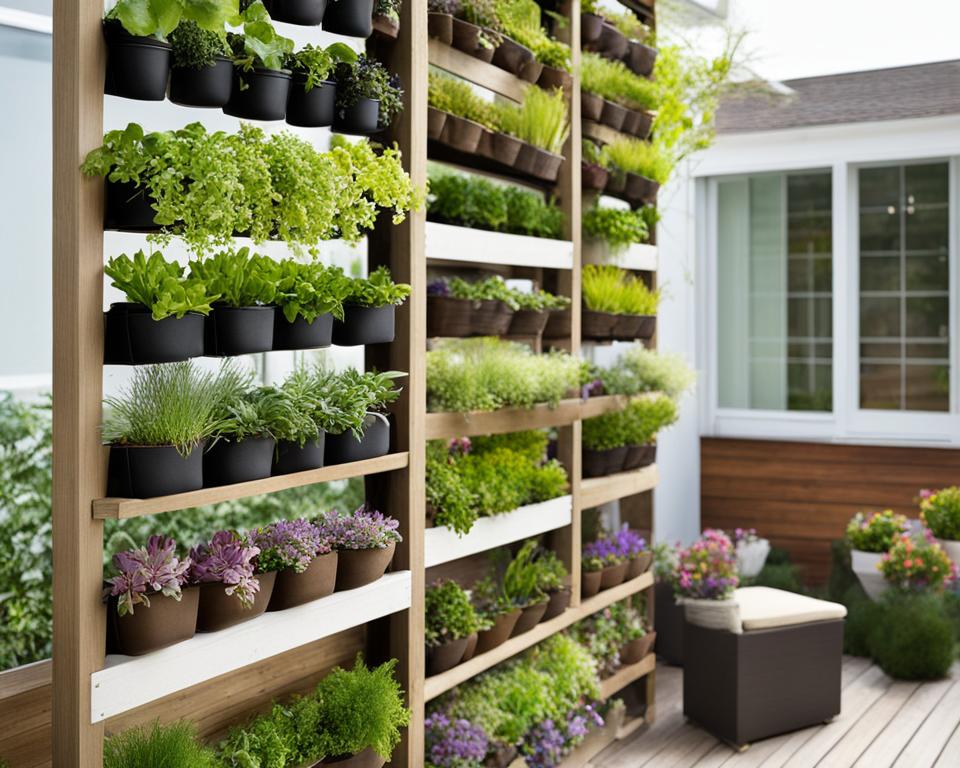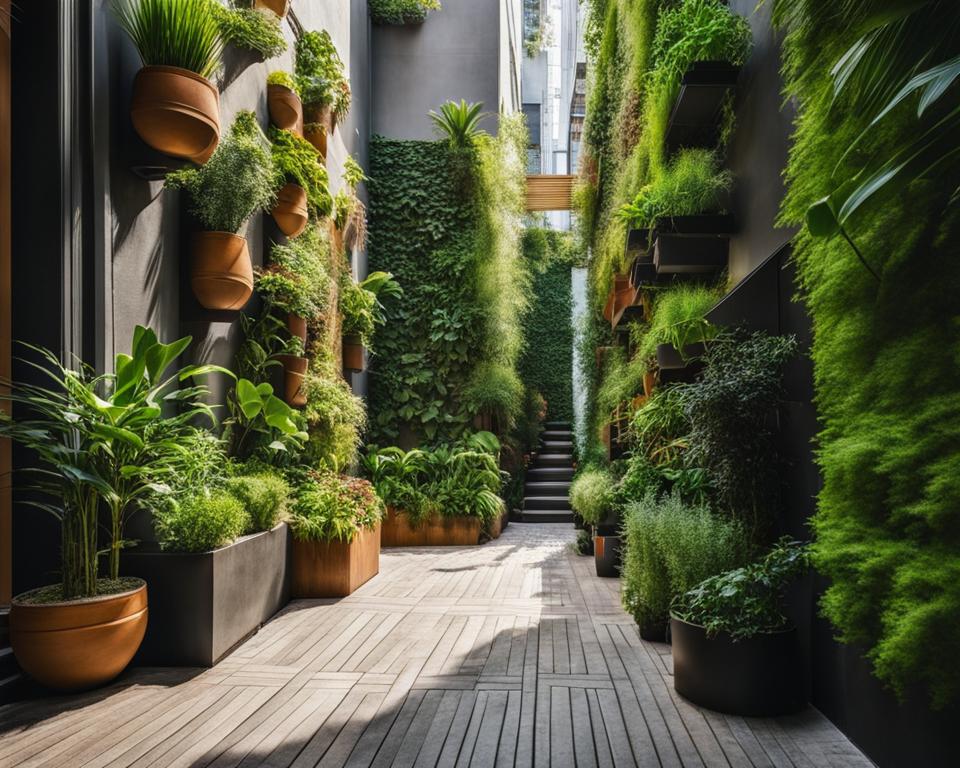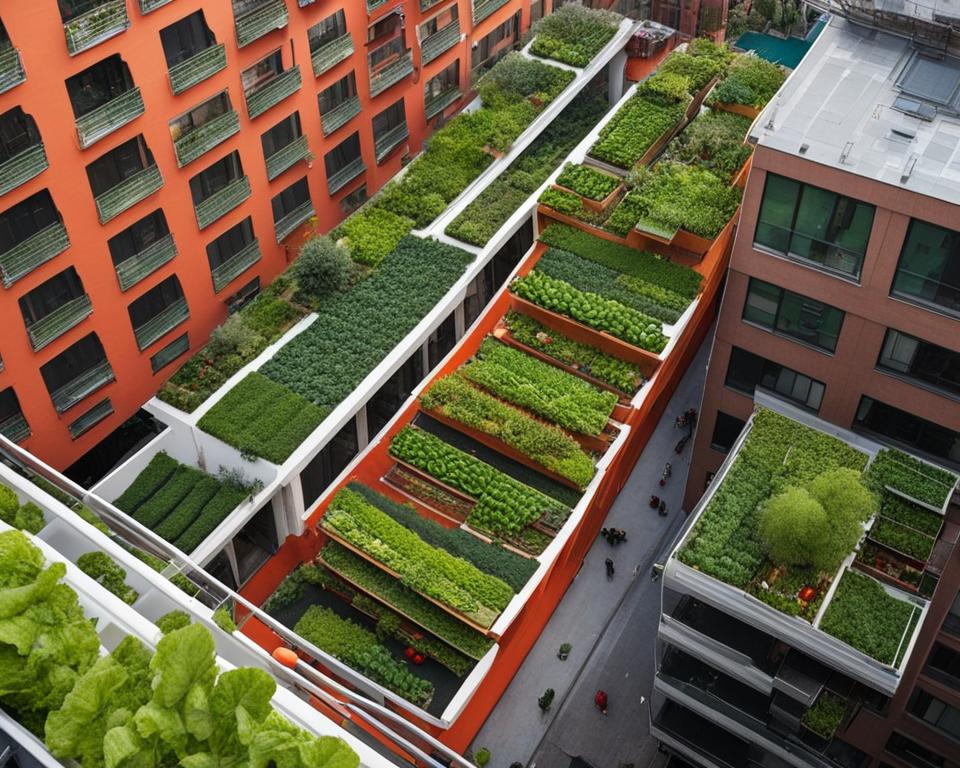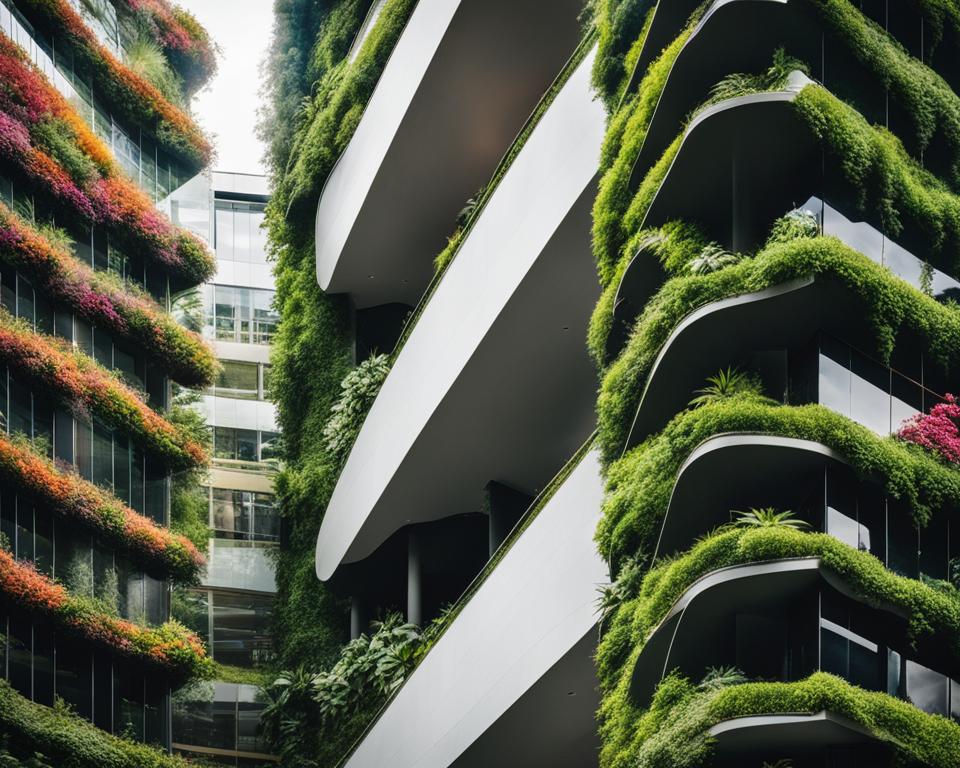If you find yourself yearning for a touch of greenery in your city dwelling, look no further than urban vertical gardening. This innovative approach to city gardening is your solution to turning that cramped apartment balcony or limited outdoor area into a lush oasis. Vertical garden design is not only about beautifying your space; it also promises a breath of fresh air—quite literally—as you cultivate your own small space gardening haven right where you live. Whether it’s yielding fresh produce on a sunny wall or bringing a pop of color to a shady corner, apartment gardening in vertical dimensions offers boundless opportunities to invigorate your urban home with life.
Key Takeaways
- Embrace vertical surfaces to expand your gardening real estate.
- Maximize small living areas for a productive garden space.
- Elevate your apartment’s aesthetic with creative vertical designs.
- Boost well-being with purer air and fresh homegrown produce.
- Contribute to sustainable urban living with vertical agriculture.
- Explore various vertical gardening systems suitable for diverse spaces.
The Versatility of Urban Vertical Gardening
When you think of urban gardening ideas, the image that often comes to mind is sprawling horizontal spaces. However, urban vertical gardening flips this perspective on its side—quite literally—allowing you to weave nature into your urban landscape with creativity and flair. With this multifaceted approach, you can transform your living area into a thriving urban vegetable garden or a blossoming oasis, proving that lack of space is no barrier to cultivating greenery and sustainability.
Consider the following urban gardening tips to optimize your vertical spaces:
- Utilize wall planters and hanging pots to create a living wall that adds texture and color to your environment.
- Select plant varieties that thrive vertically, like tomatoes, peas, and ferns, to ensure the success of your garden.
- Employ trellises and climbing structures for vine plants, which can serve as both an aesthetic and practical addition to your vertical space.
These gardens not only provide produce or a pleasant view but come with hidden benefits. They can act as natural coolants for your home or office—insulating your space from urban heat and lowering your energy bills.
| Advantages | Features | Examples |
|---|---|---|
| Space Efficiency | Vertical structure utilization | Wall-mounted herb gardens |
| Environmental Impact | Biodiversity and pollution reduction | Bee-friendly flowering plants |
| Energy Savings | Insulation benefits | Shaded living walls |
| Aesthetic Enhancement | Visual attractiveness | Colorful climbing flowers |
Remember, the beauty of urban vertical gardening is that it allows you to tailor your green space to fit your specific needs and tastes. Whether your aim is to grow fresh vegetables or create a lush backdrop for your urban retreat, the skyscraper is the limit. So roll up your sleeves, let your imagination climb new heights, and watch as your vertical garden becomes an integral piece of your urban lifestyle.
Designing Your Vertical Garden: A Blueprint for City Dwellers

Imagine transforming a blank wall into a lush tapestry of greenery; with vertical gardening systems, this vision can become a reality even if you’re working with small space gardening parameters. Vertical garden design is not just a trend—it’s an innovative and practical solution for city dwellers seeking to cultivate their own slice of nature.
Before you begin, consider the following steps to ensure that your vertical garden complements your urban lifestyle:
- Assess the lighting conditions and make sure your chosen area gets sufficient sunlight or shade, depending on the plants you wish to grow.
- Determine the watering needs of your plant selection to implement an efficient irrigation system.
- Pick a suitable style of vertical garden structure that not only supports your plants but also enhances your living space aesthetically.
Here are some popular vertical gardening systems and associated plants to get you started:
| System Type | Features | Best for Planting |
|---|---|---|
| Wall-mounted planters | Easily attached to walls, allowing for versatile arrangements | Herbs, succulents, ferns |
| Trellises | Artistic appeal; plants can weave through the structure | Climbing vines, flowering creepers |
| Modular systems | Customizable and expandable; perfect for tailored spaces | Leafy greens, small root vegetables |
Setting up your green haven might take effort, but the end result will add a touch of tranquility to your urban abode. Remember, the key to a flourishing vertical garden design is patience and innovation. Soon, you’ll be able to enjoy the verdant beauty and maybe even some homegrown flavors right from your vertical masterpiece.
Sustainable Urban Agriculture: Vertical Farming in Action
As cities grow, the challenge to meet the demands for fresh produce increases. Urban agriculture through vertical farming has emerged as a revolutionary solution, integrating sustainability into the heart of urban dwellings. By taking advantage of vertical spaces, urban residents are able to witness the transformation of their consumption patterns and enjoy the fruits of truly local labor. Allowing for the cultivation of a myriad of plants in limited spaces, vertical farming manifests as a triumph of human ingenuity in the quest for sustainable living. It’s more than gardening; it’s vertical farming in action, reshaping urban landscapes and mindsets alike.
Benefits of Urban Agriculture
Urban agriculture brims with benefits that extend beyond the mere production of food. It’s a testament to community empowerment, a catalyst for educational opportunities, and a beacon of environmental stewardship. The benefits you reap from this sustainable approach touch on economic, social, and ecological aspects of urban living. Freshness is no longer measured in miles but in steps, as produce goes directly from farm to fork without the detours of traditional food supply chains.
Implementing Vertical Farming Techniques
When you’re implementing vertical farming techniques, your approach must blend innovation with practicality. Each technique utilized is a step towards a greener future, one that prioritizes the well-being of both people and the planet. From hydroponic systems to aeroponics, the methodologies vary, but the objectives align – bountiful harvests in spaces once deemed barren. Your participation in this green revolution signals an active role in cultivating a sustainable lifestyle for generations to come.
| Vertical Farming Technique | Benefit | Best For |
|---|---|---|
| Hydroponics | Water-efficient plant growth | Leafy greens, herbs |
| Aeroponics | Maximized air circulation for roots | Root vegetables, tubers |
| Aquaponics | Symbiotic environment with fish | Variety of greens and fish species |
Green Walls and Trellises: Pioneering Urban Biodiversity

As you seek to infuse life and color into your urban dwelling, consider the transformative power of green walls and trellises. Famed not just for their aesthetic allure, these living installations stand as pillars of urban biodiversity, playing a critical role in creating thriving ecosystems right in the heart of the city.
Apartment gardening with green walls harnesses the vertical plane to cultivate a diverse array of plant species. This vertical approach does more than beautify your living space; it establishes a sanctuary for beneficial pollinators and birds, forging a symbiotic relationship between nature and urban architecture. Here are the benefits of integrating these elements into your environment:
- **Aesthetic Enhancement**: Turn a bland wall into a vibrant piece of living art that catches the eye and ignites the imagination.
- **Promotion of Biodiversity**: Offer a habitat to a variety of organisms, fostering a connection with the natural world amidst urban sprawl.
- **Air Purification**: Green walls act as natural air filters, removing pollutants and producing fresh oxygen, contributing to a healthier living environment.
- **Thermal Regulation**: The lush vegetation provides insulation, helping to regulate your apartment’s temperature and potentially lowering energy costs.
- **Noise Reduction**: The layers of plants can absorb and deflect sound, creating a quieter and more tranquil home.
Envision the positive impact a green wall could have on your daily life – a personal retreat that supports the well-being of both you and the environment. Engaging in apartment gardening through these innovative methods not only brings nature closer but also sets a precedent for sustainable urban living. So, why not join the ranks of those contributing to urban biodiversity by designing your own slice of paradise? Your cityscape and its non-human inhabitants will thank you.
The Aesthetic and Health Benefits of Urban Vertical Gardening

As you wander through a bustling cityscape, the refreshing sight of vertical gardens not only adds a burst of life to the concrete environment but also offers profound benefits for both your physical and mental health. Urban vertical gardening, a picturesque marriage of form and function, holds the promise of cleaner air and a tranquil retreat within the urban jungle.
Let’s delve into the ways these innovative green spaces are making cities more habitable and lifting the spirits of their denizens.
Improving Air Quality
Did you know that the simple addition of lush foliage on your balcony or communal spaces could significantly improve the air quality around you? Plants are nature’s own air purifiers, filtering out common pollutants and exchanging carbon dioxide for fresh oxygen. The strategic placement of these green oases throughout the city can reduce toxin levels and provide a much-needed breath of fresh air amidst the traffic fumes and industrial haze.
Boosting Mental Well-being Through Green Spaces
In the hustle of urban life, finding a moment of peace can be as simple as immersing yourself in a green space. Interaction with plants is known to lower stress levels, improve mood, and enhance concentration. Imagine stepping onto your vertical garden-adorned terrace to unwind after a long day. As the greenery envelops you, it’s not just the visual appeal that soothes your soul, but also the knowledge that you’re nurturing your personal sanctuary that enhances mental well-being.
In essence, urban vertical gardening does not just beautify cityscapes; it breathes vitality into the environment and instills a sense of serenity in our fast-paced lives. By integrating these living, breathing structures into our daily surroundings, we pave the way for healthier and more harmonious urban living.
Compact Urban Vegetable Gardens: Cultivating Nutrition in Small Spaces

Imagine biting into a crisp, just-picked cucumber from your own balcony. Envision plucking a ripe tomato from a vine that once was just a tiny plant occupying a corner of your modest outdoor area. This is the beauty of compact gardens—they defy the limitations of space and allow you to indulge in the art of cultivating nutrition. With urban vegetable gardens, apartment dwellers and small homeowners alike can enjoy fresh, organic produce, enhancing their diet and well-being.
Setting up a vertical garden is not only about maximizing space but also about creating a sustainable cycle right in the heart of the city. You can transform your wall or balcony into a lush, edible escape that doesn’t require a plot of land or a green thumb. Here are some steps to get you started on your journey:
- Analyze your space for sunlight exposure and choose the right location for each plant type.
- Select vegetable varieties that are known for thriving vertically such as peas, beans, and certain types of squash.
- Use vertical planters or create DIY trellises to maximize your growing area vertically.
- Employ companion planting techniques to maximize space and enhance plant health.
By engaging in urban vegetable gardening, you’re not just accessorizing your residence; you’re also contributing to food sustainability and taking a significant step towards a self-sufficient lifestyle. Start your compact urban vegetable garden today and transform your living space into a green sanctum that’s both beautiful and bountiful.
Creative Urban Gardening Ideas for Vertical Spaces
When it comes to bringing a touch of green to your urban dwelling, the conventional garden layout may not fit the bill. But don’t let that curb your green thumb! With creative urban gardening ideas, you can cultivate a lush oasis right in your vertical spaces.
Utilizing Upcycled Materials
Giving new life to old items not only adds character to your garden, but also promotes a sustainable lifestyle. Consider upcycled materials for your planters – pallets become chic herb gardens, bottles transform into a fascinating array of terrariums, and even that old chest of drawers can morph into a multi-tiered planter. Each upcycled piece tells a story, making your garden as unique as you are.
Innovative Vertical Garden Kits and Systems
For those who crave some structure and ease in their gardening projects, vertical garden kits are a godsend. These kits pave the way for a hassle-free setup, complete with instructions and essential components. They’re perfect for tight spaces like balconies, small patios, or even indoor walls. Whether you opt for a sleek green wall or a hanging garden kit, these systems ensure that your urban landscape thrives with minimal fuss.
- Wall-mounted planters for an artful display of succulents or air plants
- Tiered vertical stands that allow for a range of plants, from flowers to ferns
- Stackable pots that create a cascade of greenery, perfect for edible herbs
With these tips and tools, you can create a verdant retreat in the heart of the city. Ready your imagination and get gardening!
Maximizing Space with Vertical Gardening Systems
As city landscapes continue to grow and expand, maximizing space through innovative approaches has become more important than ever. Vertical gardening systems offer a creative solution, allowing you to transform even the smallest areas into lush, green environments. But how can you ensure that these systems work for you effectively?
Whether you have a tiny balcony, a small backyard, or even just a window ledge, every urban gardener has unique needs when it comes to selecting the right kind of vertical gardening system. To make the most of your available space, it’s essential to match those needs with the correct type of system.
Choosing the Right System for Your Needs
When deciding on a vertical gardening system, factors such as available light, ease of maintenance, and the types of plants you wish to grow will influence your choice. A hanging planter might be perfect for trailing tomatoes, while a wall-mounted system could better support a variety of herbs and flowers.
Optimizing Plant Selection for Vertical Growth
Selecting the right plants is just as crucial as the system you decide to use. Optimizing plant selection for vertical growth includes choosing varieties that naturally climb or can be easily trained to grow upwards, like peas, ivy, or certain types of ferns. Plants that require less soil are also great candidates for your vertical garden.
| Plant Type | Recommended System | Benefits |
|---|---|---|
| Herbs (e.g., Basil, Mint) | Hanging Planters | Easy to harvest, aromatic, requires minimal space |
| Vegetables (e.g., Tomatoes, Peppers) | Stacked Pots | Maximizes sunlight exposure, enhances fruiting |
| Flowering Vines (e.g., Morning Glory, Clematis) | Trellises | Supports vertical growth, adds visual height |
| Ferns & Foliage (e.g., Ferns, Pothos) | Wall-mounted Planters | Creates lush green walls, purifies air |
By maximizing space with the right vertical gardening systems and by optimizing plant selection, you’ll not only save on valuable ground area but also contribute to a greener, more sustainable urban environment. Start your vertical gardening journey today and witness the transformation of your personal space into a vibrant and productive green haven.
Step-By-Step Guide to Starting Your Urban Vertical Garden
If you’re aspiring to add some greenery to your urban living space, starting your urban vertical garden is a rewarding project. Whether it’s a vibrant splash on a balcony or a cozy plant corner indoors, this guide will help you create your own vertical oasis, step by step.
The first thing you’ll need is a clear location. It should offer sufficient light for your plants to thrive, but also take into consideration the possibility of shade to prevent any wilting during hotter seasons. Once your spot is chosen, it’s time to focus on selecting the right plants. Look for species known for vertical growth, like certain types of ivy, cascading herbs, or even strawberry plants.
Next up is preparing your vertical space. Whether you opt for a hanging wall planter or a freestanding trellis, ensure that it’s securely installed and ready for some planting. Here’s where you get your hands dirty—carefully plant your selections, giving them ample room to grow but ensuring they are supported.
Maintaining your garden is key. A regular watering schedule, based on your plants’ needs, paired with routine checks for pests and potential diseases, will help your vertical garden flourish.
| Action | Details | Tips |
|---|---|---|
| Location Selection | Wall, balcony, or indoor space with adequate light | East- or west-facing spots may offer ideal light conditions |
| Plant Selection | Choose plants suited for vertical growth | Vining plants and herbs often work well in vertical gardens |
| Structure Preparation | Install planters or trellises securely | Make sure your structure can support the mature weight of plants |
| Garden Planting | Plant carefully, providing support for your plants | Use quality soil and consider a drip irrigation system for ease |
| Regular Maintenance | Water, prune, and monitor plant health | Keep an eye on sunlight exposure and adjust as needed |
By following this step-by-step guide, you’ll be well on your way to cultivating a lush, vertical green space that not only livens up your urban environment but also brings you the joy of gardening.
Conclusion
As we reach the end of our exploration, it’s clear that embracing the vertical gardening movement is more than a trend—it’s a transformative practice that allows you to reimagine the possibilities of urban living. By integrating plant life into your personal spaces, regardless of size, you’re participating in a global shift towards more sustainable, breathable, and vibrant cities. Whether it’s through lush green walls or compact trellises, your efforts contribute to transforming urban spaces and making the concrete landscapes we inhabit a little greener.
Embracing the Vertical Gardening Movement
You are part of a growing community that sees the potential in every vertical square inch. This movement isn’t just about growing plants; it’s about growing possibilities. The accessibility of vertical gardening means that everyone, from seasoned gardeners to novices, can enjoy the satisfaction of nurturing life amidst steel and stone. Your enthusiastic involvement is key as we move towards greener urban environments.
Transforming Urban Spaces into Lush Paradises
Imagine stepping onto your balcony or looking out your window to see a tapestry of greenery where there once was empty space. Vertical gardens are more than aesthetic enhancements; they’re sanctuaries that provide a respite from the urban rush. Transforming urban spaces into lush paradises benefits not only you but also your community and local ecosystems. With innovative approaches and a bit of creativity, your urban sanctuary could serve as an inspiration for many more green transformations to come.
FAQ
What is urban vertical gardening?
Urban vertical gardening is a space-efficient method of city gardening that involves growing plants up vertical surfaces. It’s perfect for small space gardening environments such as apartment balconies, compact yards, or indoor areas with limited footprint, where conventional horizontal gardening isn’t feasible.
How does vertical gardening benefit city residents?
Vertical gardening offers city residents the opportunity to grow their own plants, vegetables, and herbs even in limited spaces. It enhances the visual appeal of urban areas, improves air quality, and can contribute to mental well-being by adding greenery to concrete-heavy environments. It’s a step towards sustainable living by allowing urban dwellers to produce fresh food locally.
What are some design considerations for a vertical garden in urban spaces?
When designing a vertical garden, you’ll need to consider the amount of sunlight your space receives, the wall or structure you’ll be using, and the types of plants that will thrive in a vertical setting. Choose the right vertical gardening systems, like trellises or wall planters, and ensure you have a system for watering and maintaining your plants.
Can urban vertical gardening contribute to sustainability?
Absolutely! Urban vertical gardening supports sustainable urban agriculture by reducing the need for food transportation, using vertical space efficiently, and often requiring less water than traditional farming methods. By growing food locally, these gardens decrease the carbon footprint associated with food production and distribution.
What is the role of green walls and trellises in urban biodiversity?
Green walls and trellises can host a variety of plants and provide habitats for local wildlife, promoting biodiversity in the city. They can act as natural air filters and insulators, improving the local ecosystem and the urban environment both aesthetically and ecologically.
How does urban vertical gardening improve air quality and mental well-being?
Plants are natural air purifiers, absorbing pollutants and carbon dioxide while releasing oxygen. Having a vertical garden can significantly improve the air quality in your immediate environment. Moreover, being around greenery has been shown to reduce stress and promote feelings of peace, which can be especially beneficial in the hustle and bustle of city living.
What can you grow in an urban vertical vegetable garden?
In an urban vertical vegetable garden, you can grow a variety of produce including herbs like basil and mint, leafy greens such as lettuce and spinach, and even some fruits like strawberries or cherry tomatoes. Choose plants that are well-suited to vertical growth and the specific conditions of your garden area.
How can you be creative with urban garden designs in small spaces?
Get creative with your urban garden by using upcycled materials as planters, such as wooden pallets, plastic bottles, or old furniture. Consider innovative vertical garden kits and systems that can help you maximize your space aesthetically while being functional for plant growth.
How do you pick the right vertical gardening system for your space?
Evaluate factors like available light, ease of watering, and the weight-bearing capacity of your walls or balcony. Also, think about the plants you wish to grow; some systems like hydroponics may be better suited for vegetables, while others like pocket planters may be ideal for ornamental plants.
Can you provide a step-by-step guide to starting an urban vertical garden?
To start your urban vertical garden, first, choose a location that gets adequate sunlight. Select appropriate plants that grow vertically and prepare your vertical garden structure. Install the system carefully, plant your seeds or seedlings, and establish a routine for watering, pruning, and maintenance to ensure your garden thrives.

